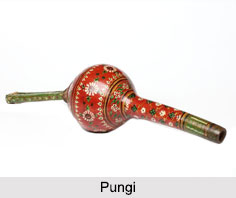 Pungi is a wind instrument in India which is also known as the snake-charmer`s wife. While it is extremely common, it goes under different names like Pungi, Been, Tumbi, Nagasar, Sapurer Bansi in northern areas; Nagasvaram, Mahudi, Pungi and Pambatti Kuzhal in the southern parts of the country. The instrument is consisted of a mouth-blown air reservoir, which is made out of gourd. This reservoir channels air into two reed pipes. Pungi is played with no interruptions providing circular breathings by the player. It is still played by the snake charmers in streets. Pungi is considered to be one of the many ways to communicate with Gods.
Pungi is a wind instrument in India which is also known as the snake-charmer`s wife. While it is extremely common, it goes under different names like Pungi, Been, Tumbi, Nagasar, Sapurer Bansi in northern areas; Nagasvaram, Mahudi, Pungi and Pambatti Kuzhal in the southern parts of the country. The instrument is consisted of a mouth-blown air reservoir, which is made out of gourd. This reservoir channels air into two reed pipes. Pungi is played with no interruptions providing circular breathings by the player. It is still played by the snake charmers in streets. Pungi is considered to be one of the many ways to communicate with Gods.
History of Pungi
Pungi was initially developed as an instrument to accompany Folk Music in India. Then it was used for religious purposes and for snake charming. It was also popular in the Badagutittu (a traditional Indian theatre form) about 50 years ago.
Structure of Pungi
Whatever be the differences in name, the construction is generally the same throughout the country. Usually the Pungi is about 1 to 2 feet in length. As a matter of tradition, the Pungi is made from a dry bottle-gourd. It consists of a small calabash which serves as an air reservoir and to which are attached reed or bamboo pipes. The Pungi has two reed pipes known as Jivala. One of the reeds is for the melody while the other is for the drone. At the top there is one tube inserted into the gourd. This is a simple open flue into which the snake-charmer blows. The air is collected in the bottle gourd and passed out through two pipes fixed at its lower end. Each of these has a single beating reed and gives out the sound; but one of them acts only as a drone and the melody is played on the other. In recent specimens one may come across a long metallic tube, besides the two bamboo ones. This also functions as a drone. The neck of the gourd is often seen as being carved. This is mainly for aesthetic reasons. There are no pauses when the Pungi is played. Thus the most common technique used for playing the Pungi is that of circular breathing.




















